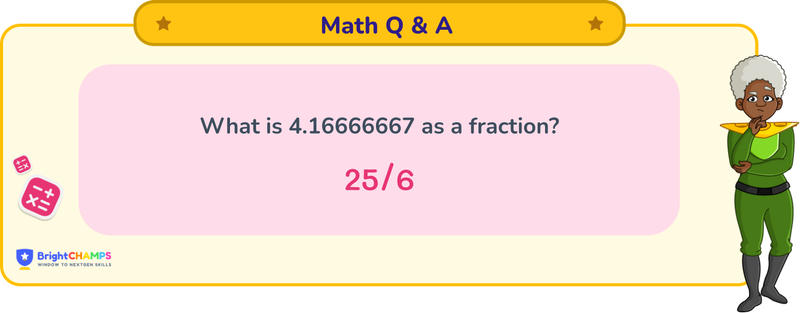
 160 Learners
160 LearnersLast updated on May 26th, 2025

4.16666667 as a Fraction

Numbers can be categorized into different types. Fraction is one of its kinds. It is always represented in the form of p/q, where p is the numerator and q is the denominator. Fraction represents a whole and a fractional part. Decimals represent the fractional part of numbers. For example, 1/2, the numbers in decimal are expressed with a decimal point (.), For example, 4.16666667, we are going to learn how to convert a decimal to a fraction.
What is 4.16666667 as a Fraction?
Answer
The answer for 4.16666667 as a fraction will be 25/6.
Explanation
Converting a decimal to a fraction is a task for students that can be done easily. You can follow the steps mentioned below to find the answer.
Step 1: Firstly, any decimal number should be converted to a fraction for easy calculation. Here, 4.16666667 is the number on the numerator and the base number 1 will be the denominator. Then, 4.16666667 becomes 4.16666667/1.
Step 2: To deal with the repeating decimal part, first separate the whole number and the repeating decimal part. Here, 4.16666667 can be written as 4 + 0.16666667.
Step 3: The repeating decimal 0.16666667 (or 0.1666...) can be expressed as 1/6. To convert, let x = 0.1666..., then 10x = 1.6666... Subtracting these, we get 9x = 1.5, leading to x = 1/6.
Step 4: Now, the whole number part is 4, and the fractional part is 1/6. To combine these, we convert 4 to a fraction with a denominator of 6: 4 = 24/6.
Step 5: Add the fractions: 24/6 + 1/6 = 25/6.
Thus, 4.16666667 can be written as a fraction 25/6.
Important Glossaries for 4.16666667 as a Fraction
- Fraction: A numerical quantity that is not a whole number, representing a part of a whole.
- Decimal: A number that uses the base ten and includes a decimal point to separate the whole part from the fractional part.
- Numerator: The top part of a fraction, indicating how many parts of the whole are being considered.
- Denominator: The bottom part of a fraction, showing how many parts make up a whole.
- Repeating Decimal: A decimal in which a sequence of digits repeats infinitely.





